TENDA TECHNOLOGY 268R 150Mbps Wireless‐N Router User Manual
SHENZHEN TENDA TECHNOLOGY CO., LTD. 150Mbps Wireless‐N Router
Users Manual

11N Wireless Broadband Router User Guide
1
Wireless-N Broadband Router
W268R
Notice
RF Exposure Statement
To maintain compliance with FCC’s RF Exposure
guidelines, This equipment should be installed and
operated with minimum distance between 20cm the
radiator your body: Use only the supplied antenna.

11N Wireless Broadband Router User Guide
2
Copyright Statement
is the registered trademark of Shenzhen
Tenda Technology Co., Ltd. All the products and product
names mentioned herein are the trademarks or
registered trademarks of their respective holders.
Copyright of the whole product as integration, including
its accessories and software, belongs to Shenzhen Tenda
Technology Co., Ltd. Without the permission of Shenzhen
Tenda Technology Co., Ltd, any individual or party is not
allowed to copy, plagiarize, reproduce or translate it into
other languages.
All the photos and product specifications mentioned in
this manual are for references only. Upgrades of software
and hardware may occur, and if there are changes, Tenda
is not responsible for notifying in advance. If you would
like to know more about our product information, please
visit our website at www.tenda.cn.

11N Wireless Broadband Router User Guide
3
Contents
CHAPTER 1 PRODUCT INTRODUCTION.........................................1
1.1 PACKAGE CONTENTS.............................................................................2
1.2 LED INDICATORS AND PORT DESCRIPTION ......................................2
CHAPTER 2 PRODUCT INSTALLATION............................................5
CHAPTER 3 HOW TO CONFIGURE TO ACCESS THE
INTERNET...................................................................................................7
3.1 HOW TO SET THE NETWORK CONFIGURATIONS...............................7
3.2 LOG IN TO THE ROUTER......................................................................14
3.3 FAST INTERNET ACCESS ......................................................................16
3.4 FAST ENCRYPTION ...............................................................................18
CHAPTER 4 ADVANCED SETTINGS................................................19
4.1 SYSTEM STATUS.....................................................................................19
4.2 WAN SETTINGS....................................................................................21
4.3 LAN SETTINGS.....................................................................................28
4.4 DNS SETTINGS.....................................................................................29
4.5 BANDWIDTH CONTROL .......................................................................30
4.6 TRAFFIC STATISTICS .............................................................................35
CHAPTER 5 WLAN SETTINGS.............................................................37
5.1 WIRELESS BASIC SETTINGS..................................................................37
5.2 WIRELESS SECURITY SETTINGS...........................................................43
5.2.1 WPS SETTINGS ..................................................................................44
5.3 WIRELESS ACCESS CONTROL ..............................................................48
5.4 CONNECTION STATUS..........................................................................49
CHAPTER 6 DHCP SERVER..................................................................49

11N Wireless Broadband Router User Guide
4
6.1 DHCP SETTINGS..................................................................................49
6.2 DHCP CLIENT LIST.............................................................................50
CHAPTER 7 VIRTUAL SERVER...........................................................52
7.1 PORT RANGE FORWARDING ...............................................................52
7.2 DMZ SETTINGS....................................................................................56
7.3 UPNP SETTINGS ..................................................................................57
CHAPTER 8 SECURITY SETTINGS ....................................................58
8.1 CLIENT FILTER SETTINGS....................................................................58
8.2 MAC ADDRESS FILTER........................................................................60
8.3 URL FILTER SETTINGS........................................................................63
8.4 REMOTE WEB MANAGEMENT ............................................................65
CHAPTER 9 ROUTING SETTINGS.....................................................68
9.1 ROUTING TABLE...................................................................................68
9.2 STATIC ROUTING..................................................................................68
CHAPTER 10 SYSTEM TOOLS..............................................................70
10.1 TIME SETTINGS...................................................................................70
10.2 DDNS..................................................................................................71
10.3 BACKUP/RESTORE .............................................................................73
10.4 RESTORE TO FACTORY DEFAULT.....................................................77
10.5 UPGRADE.............................................................................................77
10.6 REBOOT THE ROUTER........................................................................78
10.7 PASSWORD CHANGE...........................................................................79
10.8 SYSLOG.................................................................................................81
10.9 LOG OUT..............................................................................................82
APPENDIX 1 GLOSSARY.......................................................................83

11N Wireless Broadband Router User Guide
5
APPENDIX 2 PRODUCT FEATURES.................................................85
APPENDIX 3 FAQ....................................................................................86
APPENDIX 4 CLEAR WIRELESS CONFIGURATION...................90
APPENDIX 5 REGULATORY INFORMATION...............................94

11N Wireless Broadband Router User Guide
1
Chapter 1 Product Introduction
Thank you for purchasing the Tenda W268R
Wireless Broadband Router!
This easy-to-use router provides simple
configuration interface which enables you to configure it
with ease. It is based on the latest IEEE802.11n
standard, and is backward compatible with devices of
IEEE802.11b/g standards.
The W268R,including router, wireless AP, four-port
switch and firewall in one,provides powerful online
monitor function and supports URL filter and MAC filter.
With WDS function, it can repeat and amplify wireless
signals so as to enlarge network coverage area. It truly
supports UPnP and WMM to make your audio and video
smoother. With QoS function, it can efficiently distribute
the downloading rate for the clients. Additionally, with
super compatibility, the router can break the access
limits in some areas so that multiple computers can
share the Internet access.

11N Wireless Broadband Router User Guide
2
1.1 Package Contents
Please verify the following items after you open the
package:
¾ One W268R Wireless Broadband Router
¾ One Quick Installation Guide
¾ One Power Adapter
¾ One Software CD
If any of the listed items are missing or damaged,
please contact the Tenda reseller for immediate
replacement.
1.2 LED Indicators and Port Description
Panel and LED indicators show:

11N Wireless Broadband Router User Guide
3
LED indicator description on the front panel
Back panel port show
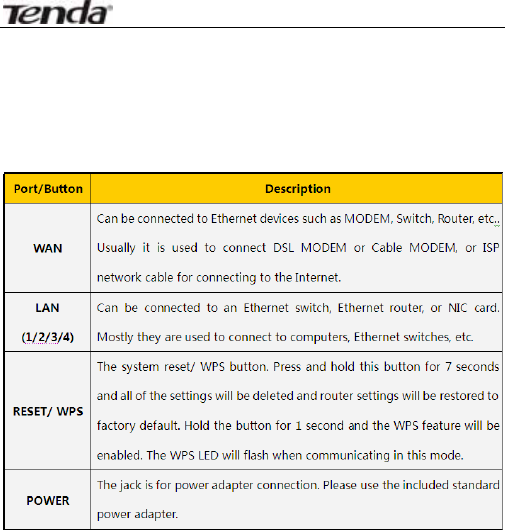
11N Wireless Broadband Router User Guide
4
Back panel port description

11N Wireless Broadband Router User Guide
5
Chapter 2 Product Installation
1. Please use only the included power adapter to
power your router. (NOTE: Use of an unmatched
power adapter could cause damage to this product).
2. Please connect the router’s LAN port to your
computer with an Ethernet cable as shown below.
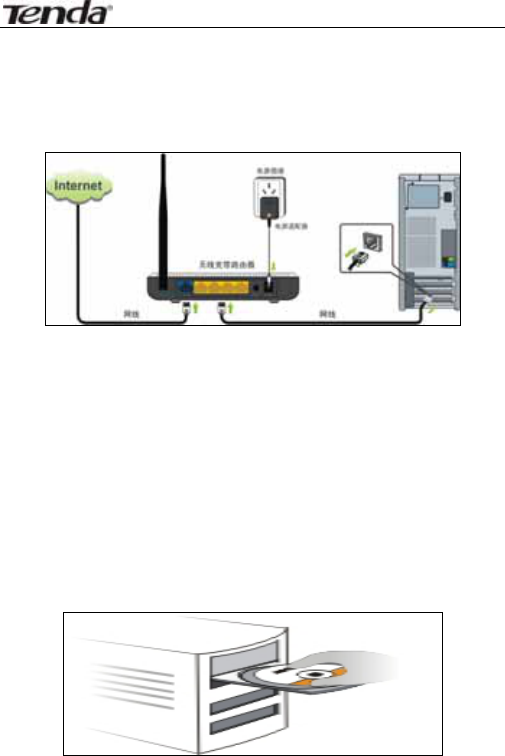
11N Wireless Broadband Router User Guide
6
3. Please connect your broadband line provided by your
ISP to the router’s WAN port.
4. Insert the included software CD into the CD drive of
your computer. After the software automatically
initiates, double click the “Setup” icon and follow the
instructions to complete the installation. You can also
enter the router’s Web-based Utility to complete the
configuration.
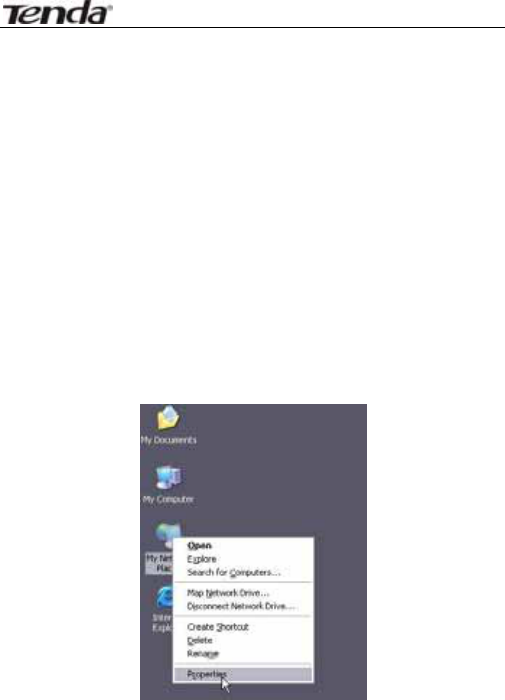
11N Wireless Broadband Router User Guide
7
Chapter 3 How to configure to access
the Internet
3.1 How to Set the Network Configurations
Network Configurations under windows XP
1. Right click “My Network Places” on your computer
desktop and select “Properties”.
2. Right click “Local Area Connection” and select
“Properties”.

11N Wireless Broadband Router User Guide
8
3. Select “Internet Protocol (TCP/IP)” and click
“Properties”.
4. Select “Obtain an IP address automatically” and
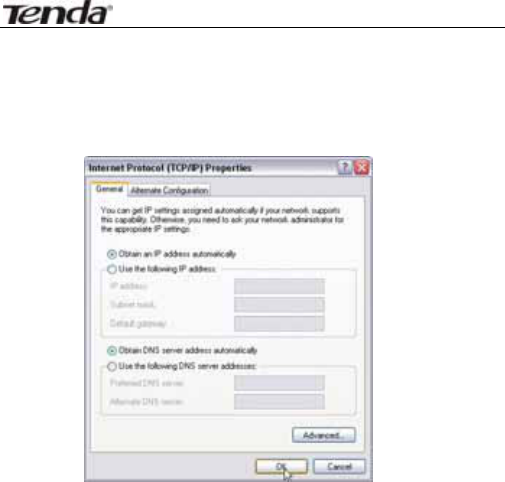
11N Wireless Broadband Router User Guide
9
“Obtain DNS server address automatically”.
Click “OK” to save the configurations.
Or select “Use the following IP address” and enter
the IP address, Subnet mask, Default gateway as
follows:
¾ IP Address: 192.168.0.XXX: (XXX is a number
from 2~254)
¾ Subnet Mask: 255.255.255.0
¾ Gateway: 192.168.0.1
¾ DNS server: You should input the DNS server
address provided by your ISP. Otherwise, you can
enter 192.168.0.1. Click “OK” to save the
configurations.
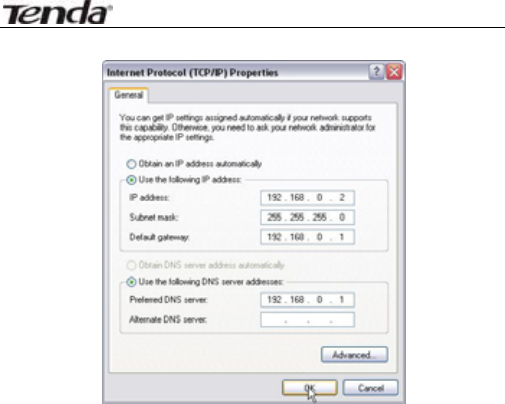
11N Wireless Broadband Router User Guide
10
Network Configurations under windows 7
1. Click the network icon on the lower right corner of
your computer desktop, and then click” Open Network
and Sharing Center”.
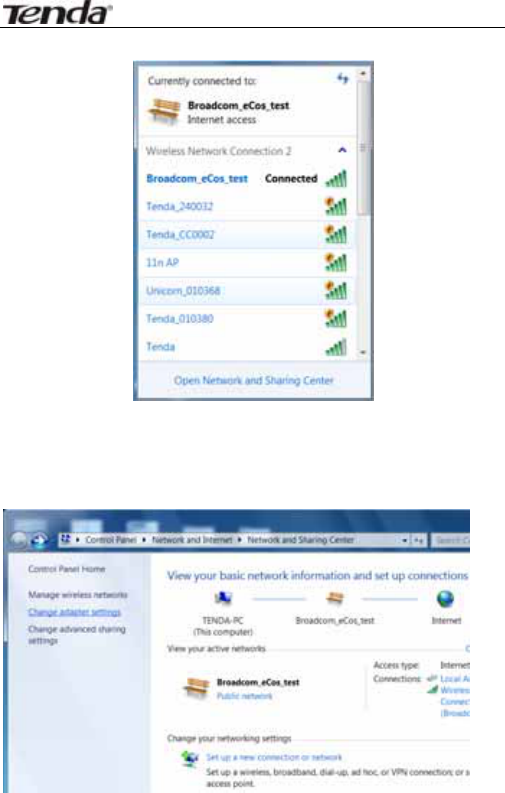
11N Wireless Broadband Router User Guide
11
2. Click “Change adapter settings” on the left side of the
window.
3. Right click “Local Area Connection” and select
“Properties”.
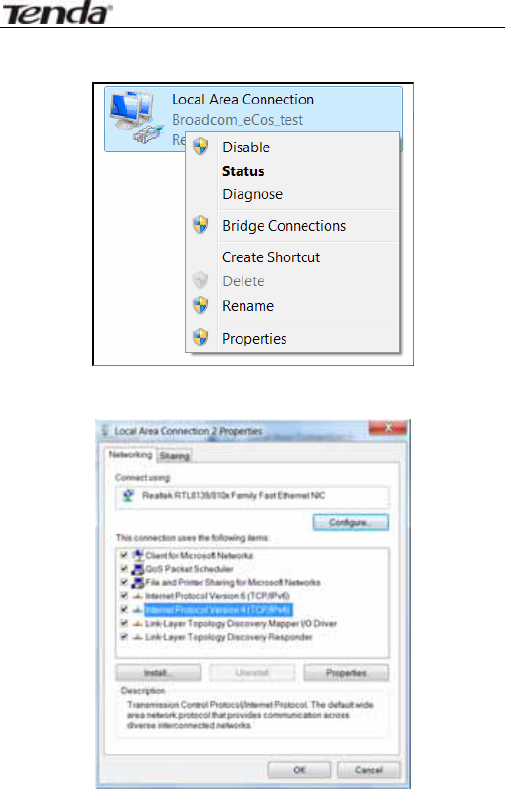
11N Wireless Broadband Router User Guide
12
4. Double click” Internet Protocol Version 4(TCP/IPv4)".
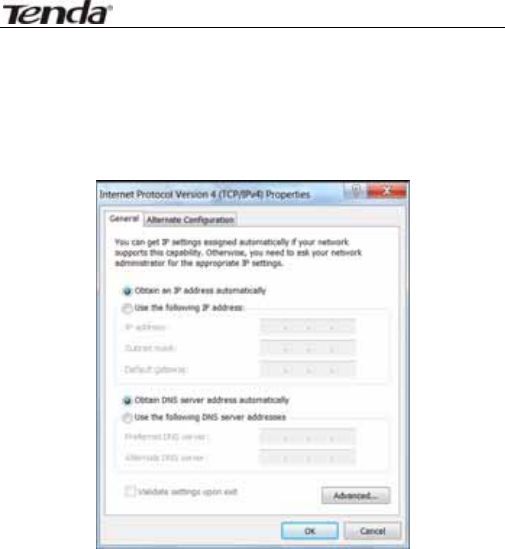
11N Wireless Broadband Router User Guide
13
5. Select “Obtain an IP address automatically” and
“Obtain DNS server address automatically”.
Click “OK” to save the configurations.
Or select “Use the following IP address” and enter
the IP address, Subnet mask, Default gateway as
follows:
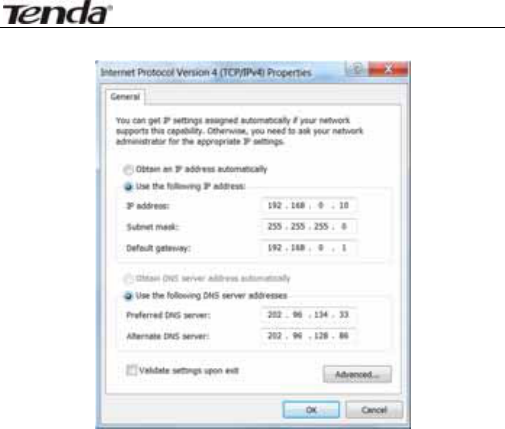
11N Wireless Broadband Router User Guide
14
¾ IP Address: 192.168.0.XXX: (XXX is a number
from 2~254)
¾ Subnet Mask: 255.255.255.0
¾ Gateway: 192.168.0.1
¾ DNS server: You should input the DNS server
address provided by your ISP. Otherwise, you can
enter 192.168.0.1. Click “OK” to save the
configurations.
3.2 Log in to the Router
1. To access the Router’s Web-based Utility, launch a
web browser such as Internet Explorer or Firefox and
enter http://192.168.0.1. Press “Enter”.

11N Wireless Broadband Router User Guide
15
2. Type “admin” in the “Password” field. Click “OK”.
3. If you enter the correct password, you will come to
the router’s web-based utility as is shown below.
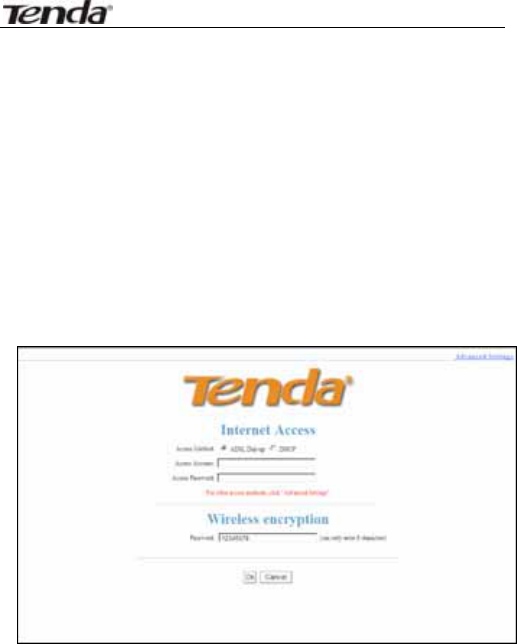
11N Wireless Broadband Router User Guide
16
3.3 Fast Internet Access
Two kinds of fast access methods are provided on the
router’s web-based utility: ADSL dial-up and DHCP.
If you select ADSL dial-up, you only need to enter the
access account and access password as well as the
wireless password, and then click “Ok” to complete the
settings.
If you select DHCP, you only need to enter the wireless
password and click “Ok” to complete the settings.

11N Wireless Broadband Router User Guide
17
The default access method is ADSL dial-up and the
access account and access password are the same as
the ADSL dial-up account and password, which you can
inquire your broadband ISP. For other access methods,
please refer to WAN settings in chapter 4.The wireless
password can only consist of 8 characters, the default is
12345678 and you can modify it when necessary.
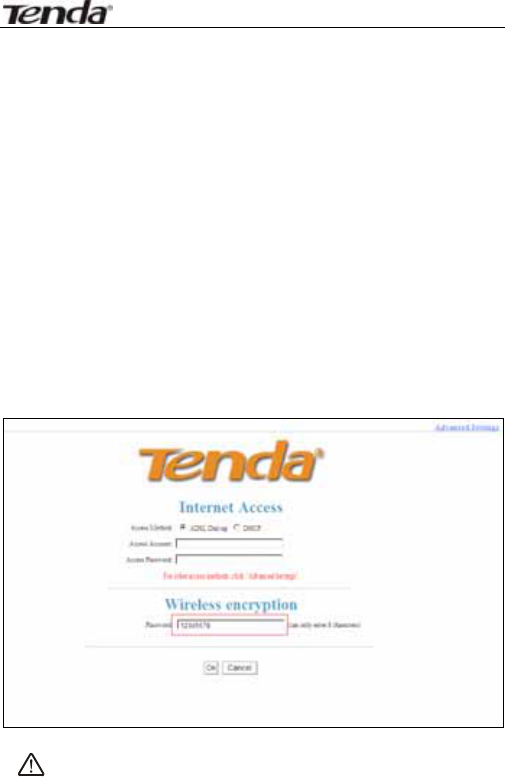
11N Wireless Broadband Router User Guide
18
3.4 Fast Encryption
The router provides two encryption setting screens,
one is simple and easy, the other is advanced (For
advanced setting, please refer to chapter 5.2).
Simple and easy screen:
Log on to the router’s web-based utility and you may
set encryption for the router. The default adopts
WPA-PSK mode and AES Algorithm. The default
password is 12345678, as shown below.
NOTE: The wireless password can only be 8
characters in length and the default is 12345678, you
can modify it when necessary.

11N Wireless Broadband Router User Guide
19
Chapter 4 Advanced Settings
4.1 System Status
System status screen allows you to view the router’s
WAN port status and system status.
Connection status: It displays the router’s WAN
connection status.
Disconnected: It indicates the router’s WAN port
hasn’t been connected with the network cable.
Connecting: It indicates the router’s WAN port is
obtaining IP address.
Connected: It indicates the Router is well
connected with the ISP.
WAN IP:IP address obtained from ISP.
Subnet mask: Obtained from ISP.
Gateway: Obtained from ISP.
DNS server: Obtained from ISP.
Alternate DNS server: Obtained from ISP.
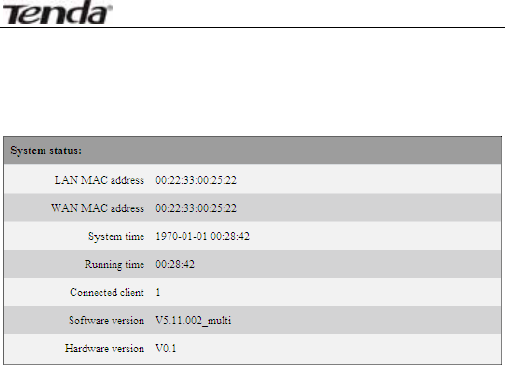
11N Wireless Broadband Router User Guide
20
Connection type: It displays your current access
method.
LAN MAC address:It displays the Router’s LAN
MAC address.
WAN MAC address:It displays the Router’s WAN
MAC Address.
System time:It displays the system’s updated
time
Connected client :It displays the number of the
connected computers(normally it displays the
number of clients whose IP addresses obtained via
DHCP server)
Software version :It displays the Router’s
software version;
Hardware version:It displays the Router’s
hardware version.

11N Wireless Broadband Router User Guide
21
4.2 WAN Settings
Virtual Dial-up (PPPoE)
¾ Mode: Show your current connection mode.
¾ Access Account: Enter the account provided by
your ISP.
¾ Access Password: Enter the password provided
by your ISP.
¾ MTU: Maximum Transmission Unit. It is the size of
the largest data packet that can be sent over the

11N Wireless Broadband Router User Guide
22
network. The default value is 1492. Do NOT modify
it unless necessary, but if a specific website or web
application software cannot open or be enabled,
you can try to change the MTU value to 1450, 1400,
etc.
¾ Service Name: The connection name for current
PPPOE, enter it if necessary,otherwise, leave it
blank.
¾ AC Name: The service name, enter it if necessary,
otherwise, leave it blank.
¾ Connect Automatically: Connect automatically
to the Internet after rebooting the system or
connection failure.
¾ Connect on Demand: Re-establish your
connection to the Internet after the specific time
(Max Idle Time). Zero means you are connected to
the Internet all times. Otherwise, enter the
minutes to be elapsed before you are disconnected
from the Internet.
¾ Connect Manually: Connect to the Internet by
users manually.
¾ Connect on Fixed Time: Connect to the Internet
during the time you fix automatically.
NOTE:
The “Connect on Fixed Time” goes into effect
only when you have set the current time in “Time
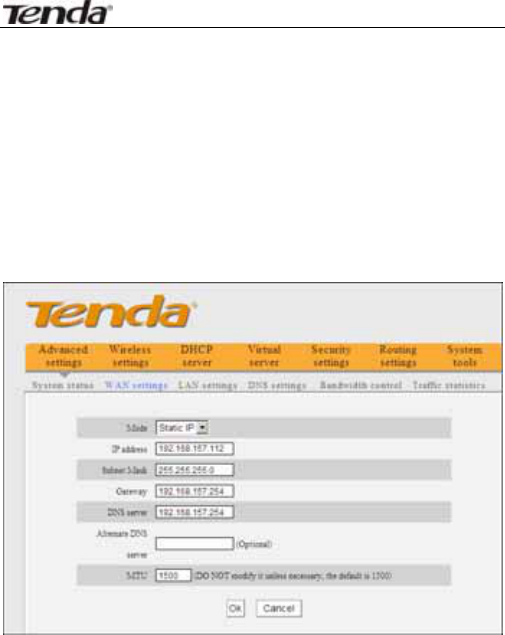
11N Wireless Broadband Router User Guide
23
settings” from “System tools”.
Static IP
If your ISP provides you the static IP, please choose
static IP, and you need to enter the IP address, subnet
mask, gateway, DNS server and alternate DNS server
provided by your ISP or network administrator。
¾ Mode: Show your current connection mode.
¾ IP address: Enter the WAN IP address provided by
your ISP. If you are not clear, please inquire your
local ISP.
¾ Subnet mask: Enter the WAN Subnet Mask
provided by your ISP. Generally it is 255.255.255.0。
¾ Gateway: Enter the Gateway provided by your ISP.
If you are not clear, please inquire your local ISP.
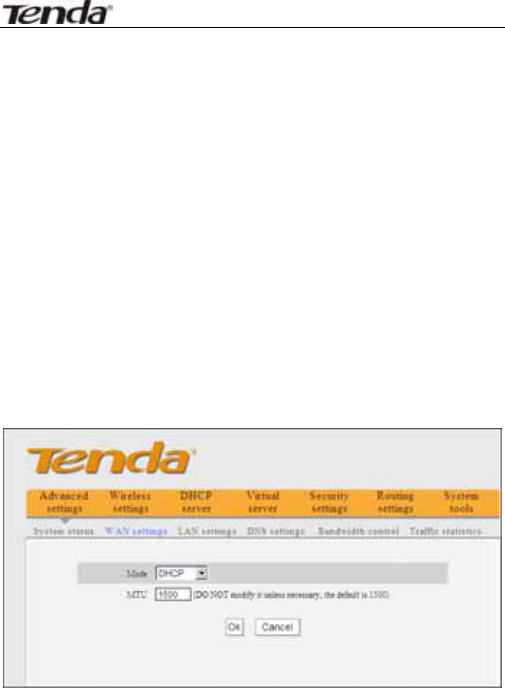
11N Wireless Broadband Router User Guide
24
¾ DNS server: Enter the necessary DNS server
provided by your ISP.
¾ Alternate DNS server: Enter the second DNS
address if your ISP provides, which is optional.
Dynamic IP (Via DHCP)
If your connection mode is Dynamic IP, it means every
time you access the Internet, you will get a different IP.
You don’t need to enter any parameters in this mode,
just Click “Ok” to finish the settings.
PPTP

11N Wireless Broadband Router User Guide
25
¾ Mode: Show your current connection mode.
¾ PPTP server address: The IP address or domain
name of the destination server and it is used to
specify the destination address which needs for
PPTP connection.
¾ Username/Password: Used to validate identity
when connecting to the PPTP server.
¾ Address mode: Set the router’s IP address mode,
you can select either “Dynamic” or “Static”. If your
ISP doesn’t provide the IP address, please select
“Dynamic”.
¾ IP address: Please enter the IP address provided
by your ISP, inquire your local ISP if you are not
clear.

11N Wireless Broadband Router User Guide
26
¾ Subnet mask: Please enter the subnet mask
provided by your ISP ,generally its 255.255.255.0
¾ Gateway: Please enter the gateway provided by
your ISP, inquire your local ISP if you are not clear.
All the above parameters are provided by ISP.
L2TP
¾ Mode: Show your current connection mode.
¾ L2TP server address: The IP address or domain
name of the destination server and it is used to
specify the destination address which needs for
L2TP connection.
¾ Username/Password: Used to validate identity

11N Wireless Broadband Router User Guide
27
when connecting to the L2TP server.
¾ Address mode: Set the router’s IP address mode,
you can select either “Dynamic” or “Static”. If your
ISP doesn’t provide the IP address, please select
“Dynamic”.
¾ IP address: Please enter the IP address provided
by your ISP, inquire your local ISP if you are not
clear.
¾ Subnet mask: Please enter the subnet mask
provided by your ISP ,generally its 255.255.255.0
¾ Gateway: Please enter the gateway provided by
your ISP, inquire your local ISP if you are not clear.
All the above parameters are provided by ISP.

11N Wireless Broadband Router User Guide
28
4.3 LAN Settings
Click “Advanced settings” –LAN settings to enter the
following screen.
¾ LAN MAC address: The Router’s LAN MAC address,
which is unchangeable.
¾ IP address: The Router’s LAN IP address (not your
PC’s IP address).The default value is 192.168.0.1;
you can change it when necessary.
¾ Subnet mask: The Router’s LAN subnet mask. The
default value is 255.255.255.0
NOTE:
Once you modify the IP address, you need to remember
it for next time you log in to the web-based utility.
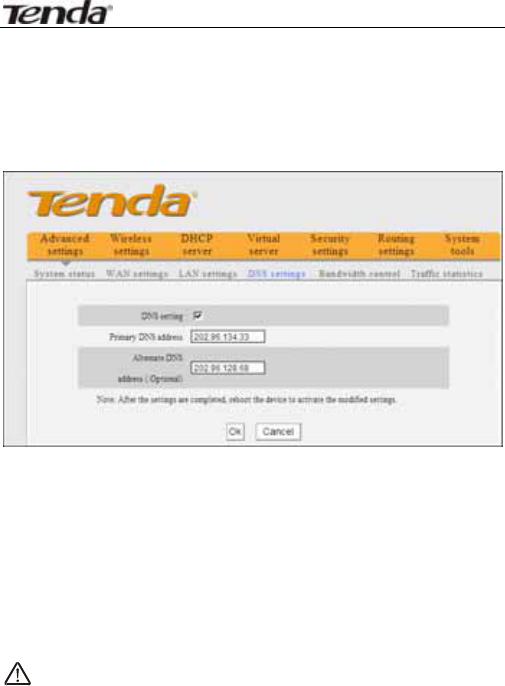
11N Wireless Broadband Router User Guide
29
4.4 DNS Settings
DNS stands for Domain Name System (or Service).
¾ DNS setting: Select to enable the DNS server.
¾ Primary DNS address: Enter the necessary
address provided by your ISP.
¾ Alternate DNS address: Enter the second DNS
address if your ISP provides, which is optional.
NOTE:
After the settings are completed, reboot the device
to activate the modified settings.
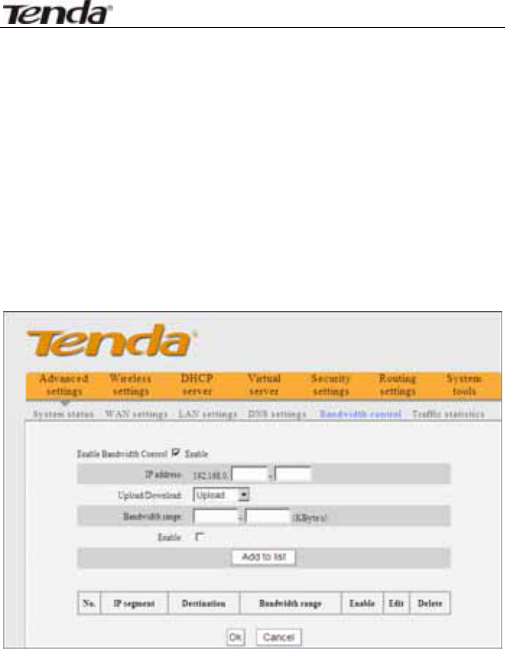
11N Wireless Broadband Router User Guide
30
4.5 Bandwidth Control
Bandwidth control is used to limit the communication
traffic of LAN computers when accessing the Internet. It
can simultaneously control maximum of 254 PCs' traffic.
In addition, IP address range configuration is
supported.
¾ Enable Bandwidth Control: To enable or disable
the internal IP bandwidth control. The default is
disabled.
¾ IP Address: The IP address range of the hosts
whose traffic has been controlled. It can be a single
IP address or IP address range.
¾ Upload/Download: To specify the traffic heading
way for the selected IP addresses: upload or

11N Wireless Broadband Router User Guide
31
download.
¾ Bandwidth Range: The maximum and minimum
upload/download data traffic of the hosts in
specified IP range. The unit is KByte/s. The uplink
of upload and download can not exceed the WAN
port bandwidth limitation range.
¾ Enable: To enable the current edited rule.
Otherwise, the rule will not go into effect.
¾ Add to list: After you edit the rule, click the “add
to list” button to add the current rule to the rule
list.
Here we take 2Mbps bandwidth as an example.
Theoretically, the biggest downloading rate for 2Mbps
bandwidth is 2Mbps=256KByte/s, and the biggest
uploading rate is 512kbps=64KByte/s
Example 1
If you want to set the download rate of the computer
at the IP address of 192.168.0.100 as 80-90KByte/s,
upload rate as 10-15KByte/s, first add one upload rule
as shown in the picture below:
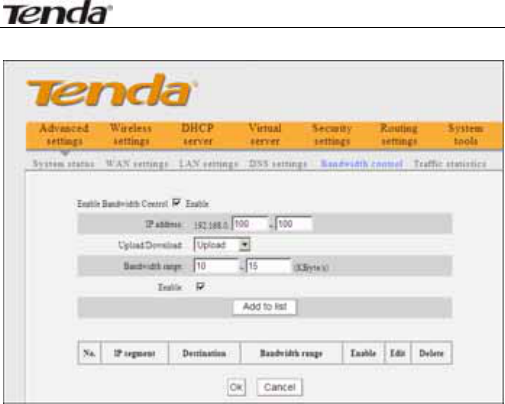
11N Wireless Broadband Router User Guide
32
1.Enter 192.168.0.100 in the IP address field
2.Select upload in the Upload/Download field.
3.Enter 10-15 in the bandwidth range field
4.Select “Enable”
5.Click “Add to list”
6.Click “Ok” to finish the upload rule settings.
And then add a download rule as shown in the picture
below.

11N Wireless Broadband Router User Guide
33
The setting method is the same as the above.
Example 2 Set the download rate of all computers
within the range of 192.168.0.2--192.168.0.254 as
100-120KByte/s, and the upload rate as 20-30KByte/s,
as shown in the picture below.
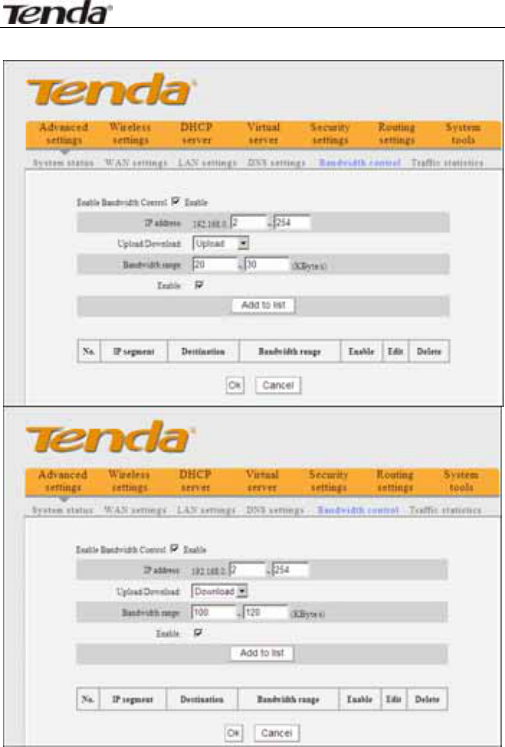
11N Wireless Broadband Router User Guide
34
The setting method is the same as Example 1.
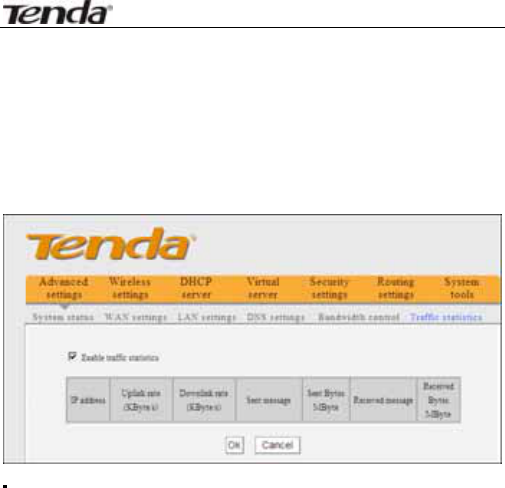
11N Wireless Broadband Router User Guide
35
4.6 Traffic Statistics
Traffic statistics is used to display the bandwidth that
LAN PC used.
Enable Traffic statistics: It is used to calculate the
traffic used by the LAN computers. You can enable it to
calculate the traffic for you. Usually, disable it to
improve the router’s data packet processing ability, and
the default is disabled. When this function is enabled,
the webpage will refresh automatically every five
minutes, meanwhile, each computer’s traffic value will
refresh automatically.
¾ IP address: the IP address of the computer whose
traffic is being calculated.
¾ Uplink rate: the data sending speed per second,
the unit is KByte/s.
¾ Downlink rate: the data receiving speed per

11N Wireless Broadband Router User Guide
36
second, the unit is KByte/s.
¾ Sent message: the number of the calculated
computer’s data packets that are sent out through
the router.
¾ Sent Bytes: the volume of the calculated
computer’s statistics that is sent out through the
router
¾ Received message: the number of the calculated
computer’s the data packets that are received
through the router.
¾ Received Bytes: the volume of the calculated
computer’s statistics that is received through the
router.
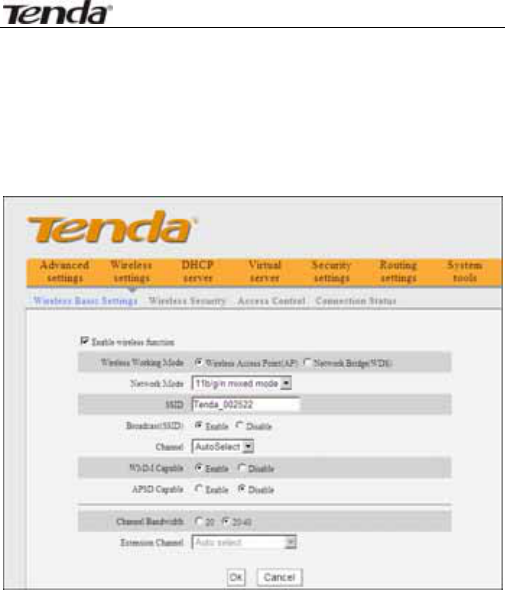
11N Wireless Broadband Router User Guide
37
Chapter 5 WLAN Settings
5.1 Wireless Basic Settings
¾ Enable wireless function: Select to enable the
Router’s wireless features; deselect to disable it
and all functions related with wireless are disabled.
¾ Wireless working mode: This router provides
two kinds of working modes: Wireless Access
Point(AP) and Network Bridge (WDS)
Wireless Access Point (AP)
¾ Network Mode: Select one mode from the

11N Wireless Broadband Router User Guide
38
drop-down list.
11b mode:Select it if you have only Wireless-B clients
in your network.
11g mode:Select it if you have only Wireless-G clients
in your network.
11b/g mixed mode: Select it if you have only
Wireless-B and Wireless-G clients in your network.
11b/g/n mixed mode: Select it if you have
Wireless-B, Wireless-G and Wireless-N clients in your
network.
¾ SSID: It is the unique name of the wireless
network and can be modified. The SSID must be
entered.
¾ Broadcast (SSID): Select “Enable” to enable the
router’ SSID to be scannable by wireless devices.
The default is enabled. If you disable it, the
wireless devices must know the SSID for
communication.
¾ Channel: The currently used channel by the router.
Select an effective channel (from 1 to 13\Auto) of
the wireless network.
¾ WMM Capable: Enable it to enhance the transfer
performance of the wirelessly transferred
multimedia data (such as video or online
playing).We recommend enabling this option if you
are not familiar with WMM.

11N Wireless Broadband Router User Guide
39
¾ APSD Capable: It is used for auto power-saved
service. The default is disabled.
¾ Channel bandwidth: Select an appropriate
channel bandwidth to enhance the wireless
performance. Select 20/40M when the network has
11b/g and 11n wireless clients. Select 20M when
the network has only non-11n wireless clients.
Select 20/40M to promote its throughput when the
wireless network is in 11n mode.
¾ Extension Channel: To confirm the network’s
frequency range in 11n mode.
Network Bridge (WDS) Settings
WDS (Wireless Distribution System) is used to expand
wireless coverage area.
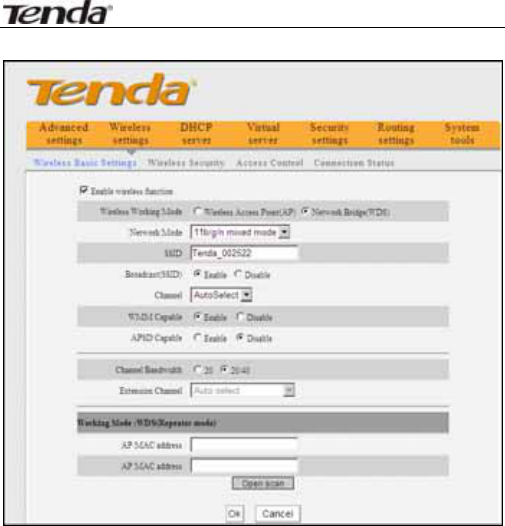
11N Wireless Broadband Router User Guide
40
¾ AP MAC address: Input the MAC address of
another (opposing) wireless router you want to
connect.
Example: This example is to bridge two 316R routers.
1. If you know the connecting router’s MAC address,
please enter it into the AP MAC address field and click
“Ok”.
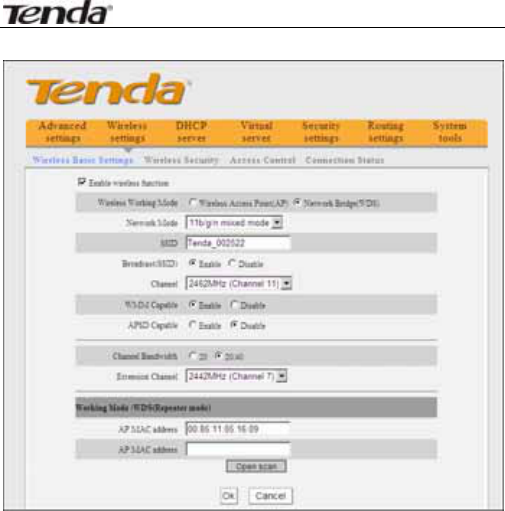
11N Wireless Broadband Router User Guide
41
2. You can also search for the wireless router’s signal by
scanning.
a) Click “Open scan” and click the scanned signal and
click the ”Ok” button on the dialog box and the
corresponding wireless MAC address will be added to
the AP MAC address field automatically.
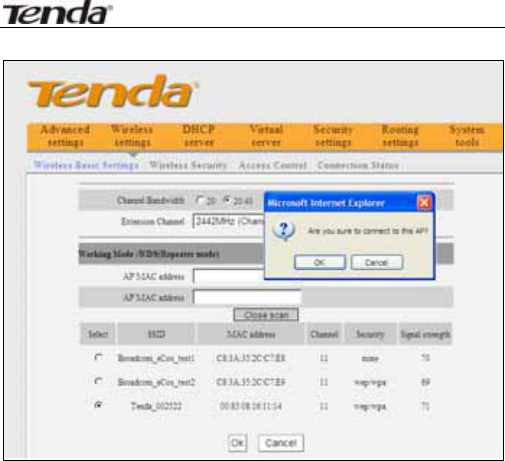
11N Wireless Broadband Router User Guide
42
b) Click “Ok” after the MAC address is added.

11N Wireless Broadband Router User Guide
43
After finishing the above steps, you need to set the
other W268R router in the same way.
NOTE: WDS feature requires both routers support
this function and the SSID, channel, encryption method
and password are the same as those of the connecting
router.
5.2 Wireless Security Settings
With the wireless security function, you can prevent
others from connecting to your wireless network and
using the network resources without your consent.
Meanwhile, you can also block illegal users from
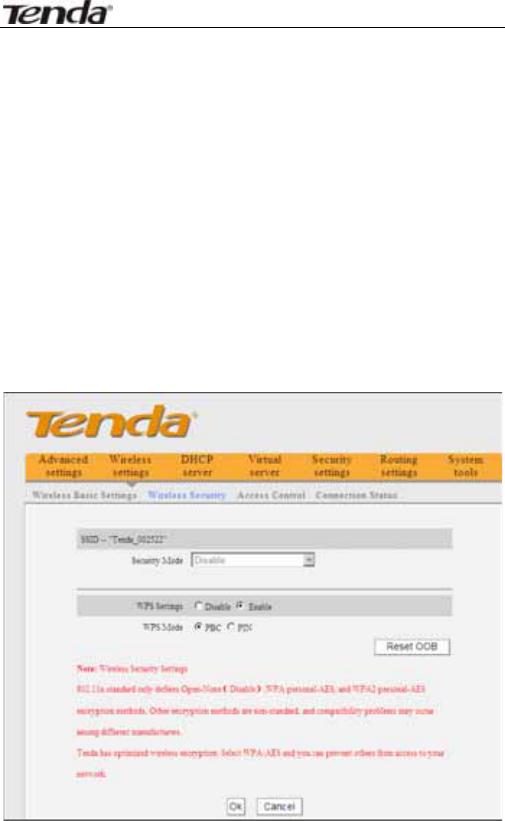
11N Wireless Broadband Router User Guide
44
intercepting or intruding your wireless network.
5.2.1 WPS Settings
WPS (Wi-Fi Protected Setting) makes it quick and easy
to establish a secure connection between the wireless
clients and the router. The users only need to enter a
PIN code or press WPS button on the back panel to
configure it without manually selecting an encryption
method or set a key.
¾ WPS settings: To enable or disable WPS function.
The default is “Enable”.

11N Wireless Broadband Router User Guide
45
¾ WPS mode: Provide two ways: PBC (Push-Button
Configuration) and PIN code.
¾ PBC: Select the PBC and click Ok, or press and
hold the WPS button on the back panel of the
device for about one second. The WPS LED
indicator will be flashing for 2 minutes, which
means the WPS is enabled. During this time
(flashing WPS LED), you can enable the wireless
client to implement the WPS/PBC negotiation
between them. When the WPS connection is
completed, the LED indicator will be continuously lit.
To add more clients, repeat the above steps.)
¾ PIN: If this option is enabled, you need to enter a
wireless client’s PIN code in the field and keep the
same code in the WPS client.
¾ Reset OOB: Press this button, the WPS client will
be in an idle state, and the WPS indicator will turn
off. AP will not respond to the WPS client’s
connection request and will set the security mode
as Open-None (Disable) mode.
NOTE: The use of WPS function requires the wireless
adapter to support this function.
5.2.2 WPA- PSK
WPA guarantees to protect WLAN users’ data and only
the authorized network users can have access to WLAN.
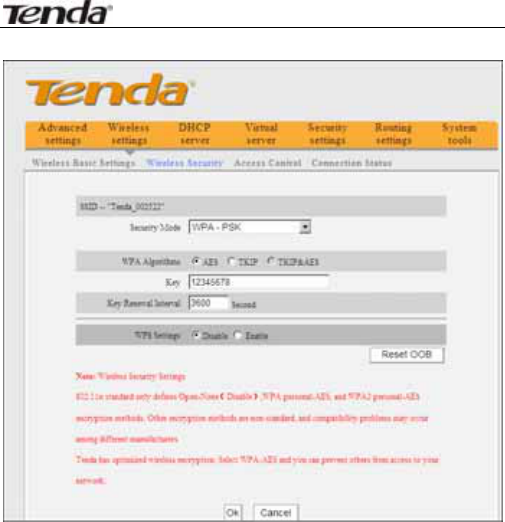
11N Wireless Broadband Router User Guide
46
¾ WPA Algorithms: Provides TKIP [Temporal Key
Integrity Protocol] or AES [Advanced Encryption
Standard].
¾ Key: Enter the pass phrase that consists of 8-63
ASCII characters.
¾ Key Renewal Interval: Set the key’s renewal
period, which tells the device how often it should
change the dynamic keys.
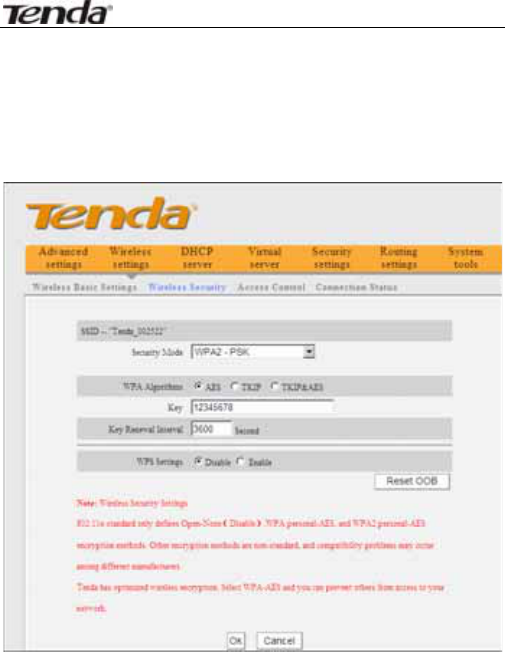
11N Wireless Broadband Router User Guide
47
5.2.3 WPA2- PSK
WPA2 (Wi-Fi Protected Access version 2) provides
higher security than and WPA (Wi-Fi Protected Access).
¾ WPA Algorithms: Provides TKIP [Temporal Key
Integrity Protocol] or AES [Advanced Encryption
Standard].
¾ Key: Enter the pass phrase that consists of 8-63
ASCII characters.
¾ Key Renewal Interval: Set the key’s renewal
period, which tells the device how often it should
change the dynamic keys.
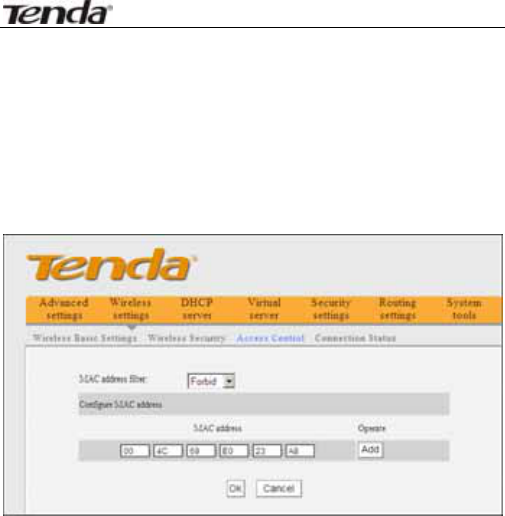
11N Wireless Broadband Router User Guide
48
5.3 Wireless Access Control
Wireless access control is actually based on the MAC
address to permit or forbid specific clients to access the
wireless network.
¾ MAC address filter: “Permit” indicates to allow
the clients in the list to access the wireless network,
“Forbid” indicates to prevent the clients in the list
from accessing the wireless network.
¾ Configure MAC address: Input the MAC
addresses of the wireless clients to implement the
filter policy. Click “Add” to finish the MAC add
operation.
¾ MAC Address list: Show the added MAC
addresses. You can add or delete them.
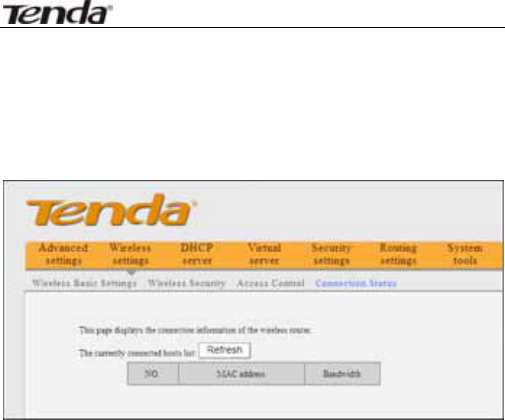
11N Wireless Broadband Router User Guide
49
5.4 Connection Status
This screen shows wireless client’s connection status,
including MAC address, Channel bandwidth.
¾ MAC address: Shows the MAC addresses of the
hosts connected to the Router.
¾ Bandwidth: Shows the channel bandwidth of the
current connected hosts (wireless clients).
Chapter 6 DHCP Server
6.1 DHCP Server
DHCP (Dynamic Host Control Protocol) is used to assign
an IP address to the computers on the LAN/private
network. When you enable the DHCP Server, the DHCP
Server will allocate automatically an unused IP address
from the IP address pool to the requesting computer in

11N Wireless Broadband Router User Guide
50
premise of activating “Obtain an IP Address
Automatically”. So specifying the start and end address
of the IP Address pool is needed.
¾ DHCP server: Check the Enable box to enable
DHCP server.
¾ IP pool start/end address: Enter the range of IP
addresses for DHCP server distribution.
¾ Lease time: It indicates the valid time of the
dynamic IP address which is distributed to the
DHCP client’s host computer by DHCP server.
During this time, the server will not distribute the
IP address to any other host computer.
6.2 DHCP Client List
DHCP client list displays user computer’ IP address,
MAC address, host name and other information which

11N Wireless Broadband Router User Guide
51
are assigned by the DHCP server. You can manually
enter the IP and MAC address and convert them to static
assignment.
¾ Host name: It displays the name of the computer
whose IP is allocated by the DHCP server.
¾ IP address: Enter the IP address which needs
static binding.
¾ MAC address: Enter the MAC address of the
computer you want to bind. Click “Add” to add the
entry in the list.
¾ Lease time: The remaining time length of the
corresponding IP address lease.
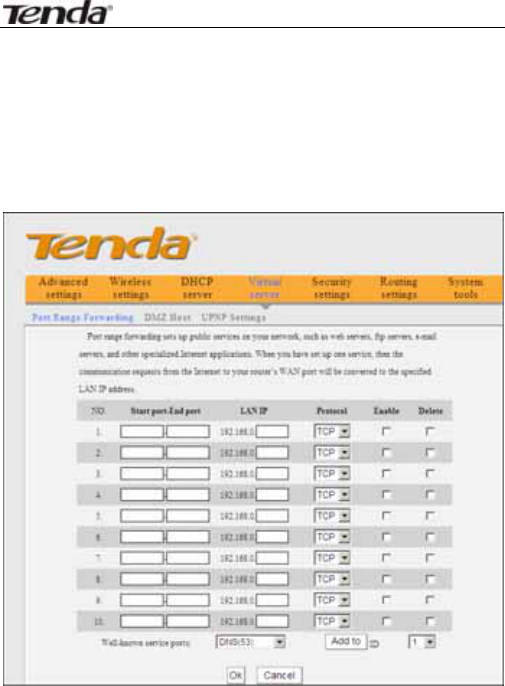
11N Wireless Broadband Router User Guide
52
Chapter 7 Virtual Server
7.1 Port Range Forwarding
¾ Start/End port: Enter the start/end port number
which ranges the External ports used to set the
server or Internet applications.
¾ LAN IP: Enter the IP address of the PC which you
want to set as the server.
¾ Protocol: Select the protocol (TCP/UDP/Both) for
the application. If you are not clear about the

11N Wireless Broadband Router User Guide
53
protocol you are using, you can select “Both”.
¾ Enable: Click the Enable checkbox to bring the set
rule into effect.
¾ Delete: Clear all settings of this item.
¾ Well-known service port: The well-known
protocol ports are listed in the drop-down list.
Select one and select a sequence number in the ID
drop-down list and then click “Add”, this port will be
added automatically to the ID list. For other well
known service ports that are not listed, you can
manually add them to the list.
¾ Add to: Add the selected well-known port to the
policy ID.
For Example: You want to share some large files with
your friends outside of your local area network, however,
they are too big, and it’s not convenient to transfer
them. Then, you can build a FTP server on your
computer and set the router’s port range forwarding to
enable your friends to access to these files on your
computer. Suppose that your FTP server or your
computer’s static IP address is 192.168.0.10, and you
wish your friends can access the server through the
default port 21 and adopts TCP protocol.
Please follow the steps below to configure.
1.Enter 21 in both start port and end port fields, or you
can also select FTP from the well-known service port
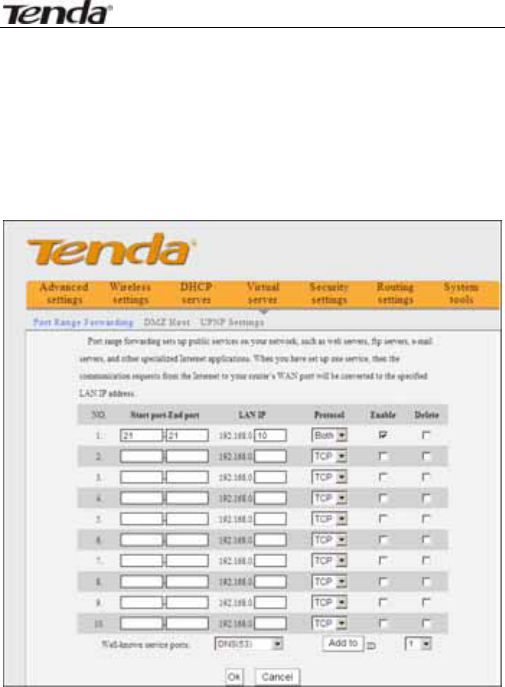
11N Wireless Broadband Router User Guide
54
and its port 21 will be added to the corresponding field
automatically.
2. Enter 192.168.0.10 in the LAN IP column, and then
select “Both” as the protocol and select “Enable”.
3. As the picture shown below.
4. Click the “Ok” button to save the settings.
And now, when your friends want to visit the FTP server,
they only need to enter ftp://xxx.xxx.xxx.xxx:21 in the
address field. Here, xxx.xxx.xxx.xxx means the router’s
WAN IP address. For example, when your router’s WAN
IP address is 172.16.102.89; your friends need to enter

11N Wireless Broadband Router User Guide
55
ftp://172.16.102.89:21 in the address field.
NOTE:
If you set the service port of the virtual server as 80,
you must set the Web management port on Remote
Web Management screen to be any value except 80
such as 8080. Otherwise, there will be a conflict to
disable the virtual server.
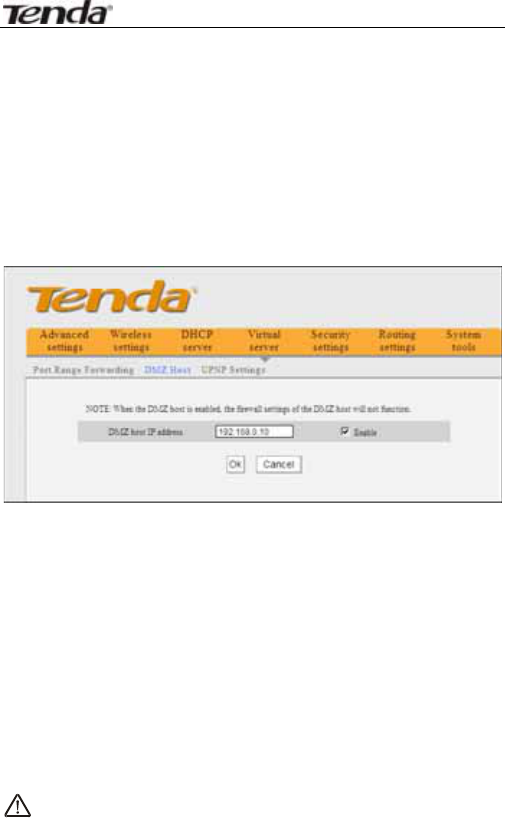
11N Wireless Broadband Router User Guide
56
7.2 DMZ Settings
The DMZ Settings screen allows one local computer to
be exposed to the Internet for use of a special-purpose
service such as Internet gaming or videoconferencing.
DMZ hosting forwards all the ports at the same time to
one PC.
¾ DMZ Host IP Address: The IP address of the LAN
computer you want to set as DMZ host.
¾ Enable: Check to enable the DMZ host.
For example:
Set the computer at the IP address of 192.168.0.10 as
DMZ host to connect another host on the Internet for
intercommunication.
NOTE: When the DMZ host is enabled, the firewall
settings of the DMZ host will not function.

11N Wireless Broadband Router User Guide
57
7.3 UPNP Settings
UPnP (Universal Plug and Play).With the UPnP function,
the internal host can request the router to process some
special port switching so as to enable the external host
to visit the resources of the internal host.
¾ Enable UPnP: Click the checkbox to enable the
UPnP.
NOTE: This function goes into effect under Windows
XP or Windows ME (NOTE: the system should integrate
or have installed the Directx 9.0) or this function would
go into effect if you have installed software that
supports UPnP.
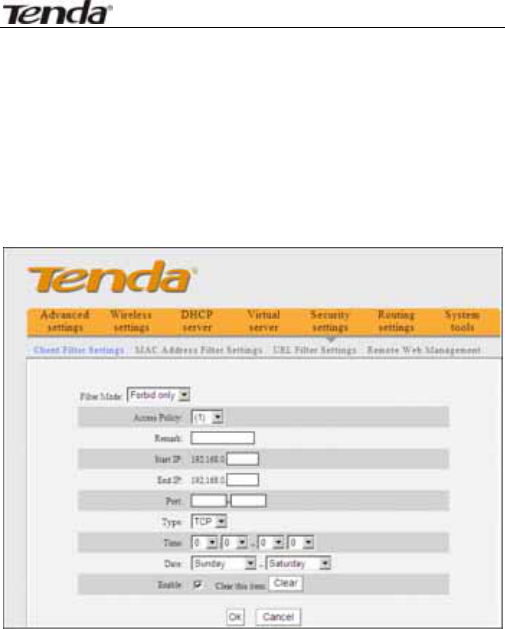
11N Wireless Broadband Router User Guide
58
Chapter 8 Security Settings
8.1 Client Filter Settings
You can enable client filter to control LAN computers’
access to some ports of the Internet。
¾ Filter Mode: You can select either “Permit only” or
“Forbid only”.
¾ Access Policy: Select one number from the
drop-down list.
¾ Remark: A simple description of the configured file.
You can also leave it blank.
¾ Start/End IP: Enter the start/end IP address.
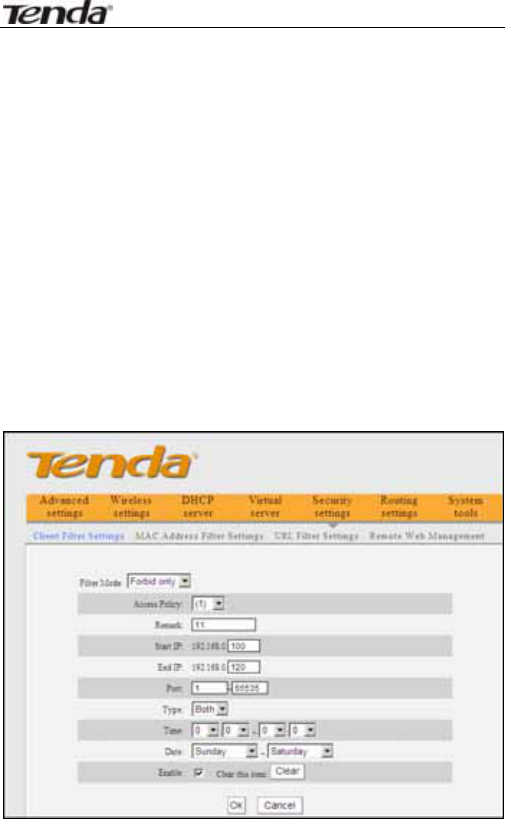
11N Wireless Broadband Router User Guide
59
¾ Port: Enter the controlled TCP/UDP protocol port.
You can specify a port or port range.
¾ Type: Select one protocol (TCP/UDP/Both) from
the drop-down list.
¾ Time: Select the time range of client filter.
¾ Date: Select the day(s) to run the access policy.
¾ Enable: To enable/disable the access policy
(forbid/permit the packets matched with the
access policy to pass through the router.
Example1 Forbid LAN computers at the IP addresses of
192.168.0.100--192.168.0.120 to access the Internet.
Example 2 Permit LAN computer with the IP address
of 192.168.0.145 to access websites during 8:00 to

11N Wireless Broadband Router User Guide
60
18:00 from Sunday to Saturday.
8.2 MAC Address Filter
You can limit the computer’s access to Internet by MAC
Address Filter.

11N Wireless Broadband Router User Guide
61
¾ Filter mode: You can select either “Permit only” or
“Forbid only”.
¾ Access Policy: Select one number from the
drop-down list.
¾ Remark: A simple description of the configured file.
You can also leave it blank.
¾ MAC Address: Enter the MAC address you want to
run the access policy.
¾ Time: Select the time range of MAC address
filter.
¾ Date: Select the day(s) to run the access policy.
¾ Enable: To enable/disable the access policy
(forbid/permit the packets matched with the
access policy to pass through the router).
Example 1 Forbid the computer with the MAC address
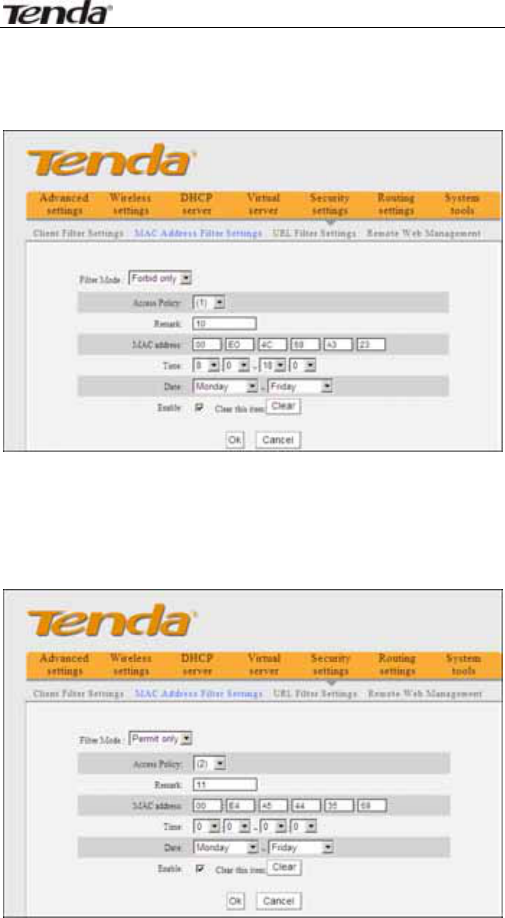
11N Wireless Broadband Router User Guide
62
of 00:E0:4C:69:A3:23 to access Internet during 8:00 to
18:00 from Monday to Friday.
Example 2 Permit the computer with the MAC address
of 00:E4:A5:44:35:69 to access Internet from
Monday to Friday.
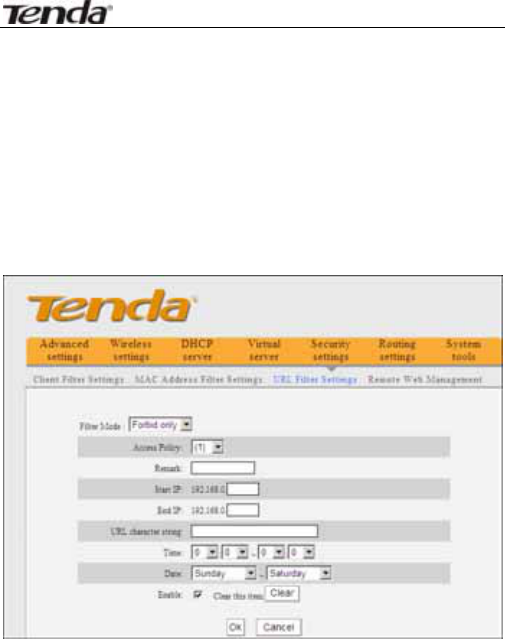
11N Wireless Broadband Router User Guide
63
8.3 URL Filter Settings
You can use URL filtering to forbid their access to
certain websites at a specified time.
¾ Filter Mode: You can select either “Permit only” or
“Forbid only”.
¾ Access Policy: Select one number from the
drop-down list.
¾ Remark: A simple description of the configured file.
You can also leave it blank.
¾ Start/End IP: Enter the start/end IP address.
¾ URL character string: Specify the text
strings or keywords needed to be filtered.
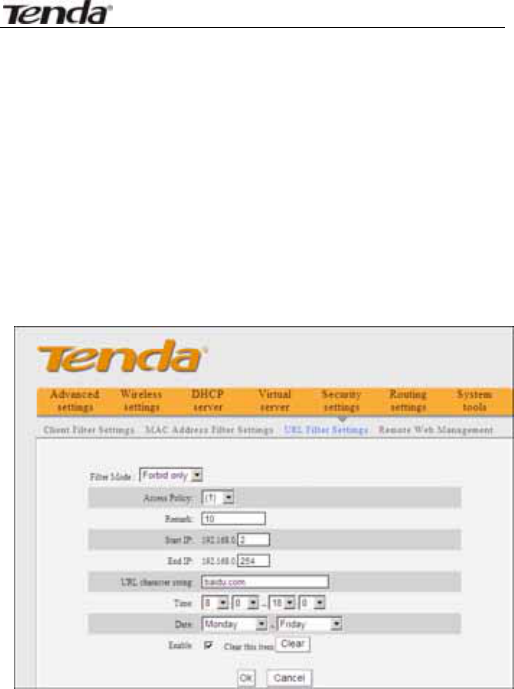
11N Wireless Broadband Router User Guide
64
¾ Time: Select the time range of URL filter.
¾ Date: Select the day(s) to run the access policy.
¾ Enable: To enable/disable the access policy (forbid
/permit the packets matched with the access policy
to pass through the router).
Example1 Forbid all computers on LAN to access
baidu.com during 8:00 to 18:00 from Monday to Friday.
Example2 Permit LAN computers with the IP
addresses of 192.168.0.100-192.168.0.115 to access
yahoo.com.

11N Wireless Broadband Router User Guide
65
NOTE: Enter only one domain name for each access
policy for one access policy can only filter one domain
name. So, if you want to filter multiple domain names,
you need to set multiple access policies
8.4 Remote Web Management
This section instructs how to allow the network
administrator to manage the Router remotely. If you
want to access the Router from outside of the local
network, please click the checkbox after “Enable”.
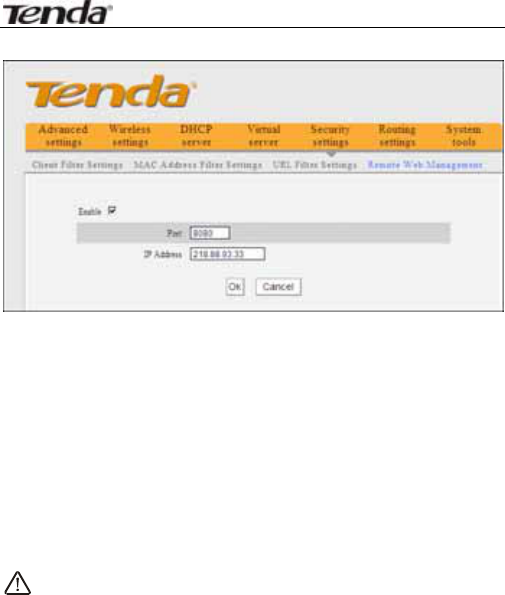
11N Wireless Broadband Router User Guide
66
¾ Enable: Check to enable remote web
management.
¾ Port: The management port open to outside
access. The default value is 80.
¾ IP Address: Specify the range of the IP addresses
of the computers on the Internet for remote
management.
NOTE:
1. If you want to log in the device’s Web-based
Utility via port 8080, you need to use the format of
WAN IP address: port (for example http :
//220.135.211.56:8080) to implement remote login.
2. If your WAN IP address starts and ends with
0.0.0.0, it means all hosts on the Internet can
implement remote Web management. If you
change the Internet IP address as
218.88.93.33-218.88.93.35, then only the
computers at the IP addresses of 218.88.93.33,
218.88.93.34 and 218.88.93.35 can access the

11N Wireless Broadband Router User Guide
67
Router to implement remote web management.
For example:
If you want to configure the computer at the IP address
of 218.88.93.33 to access the router’s web-based utility
via port 8080, please set the parameters as above.
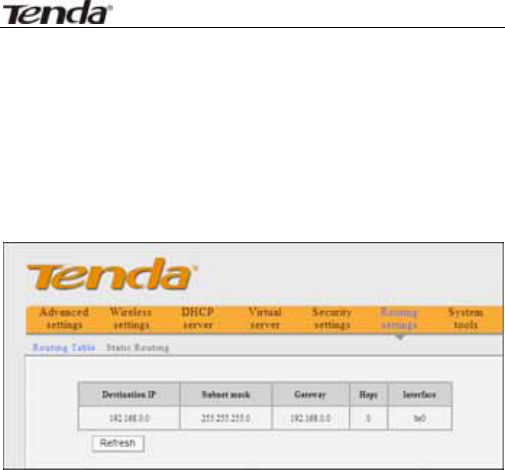
11N Wireless Broadband Router User Guide
68
Chapter 9 Routing Settings
9.1 Routing Table
This page shows the router’s core routing table.
The main duty for a router is to look for a best path for
every data packet, and transfer this data packet to a
destination station. In order to fulfill this function, many
transferring paths, i.e. routing table, are saved in the
router, for choosing when needed.
9.2 Static Routing
This screen is used to set the router’s static routing.
A static route is a pre-determined pathway that network
information must travel to reach a specific host or
network.

11N Wireless Broadband Router User Guide
69
Destination network IP address: The destination
host or IP segment you visit.
Subnet mask: Enter the subnet mask, generally it is
255.255.255.0
Gateway: The entry IP address of the next router.
NOTE:
1. The gateway must be at the same net segment with
the router’s LAN IP.
2. If the destination IP address is one host’ address,
then the subnet mask must be 255.255.255.255.
3. If the destination IP address is an IP segment, then it
must match with the subnet mask. For example, if the
destination IP is 10.0.0.0 then the subnet mask must be
255.0.0.0

11N Wireless Broadband Router User Guide
70
Chapter 10 System Tools
10.1 Time Settings
This section is to configure the router’s system time.
You can set it manually or obtain the GMT time from the
Internet.
¾ Time zone: Select the time zone where you are
operating the Router from the drop-down list.
¾ Customized time: Enter the time you wish to
configure.
NOTE:
When the Router is powered off, the time settings
will be lost. The router will obtain the GMT time
automatically when you next time access the
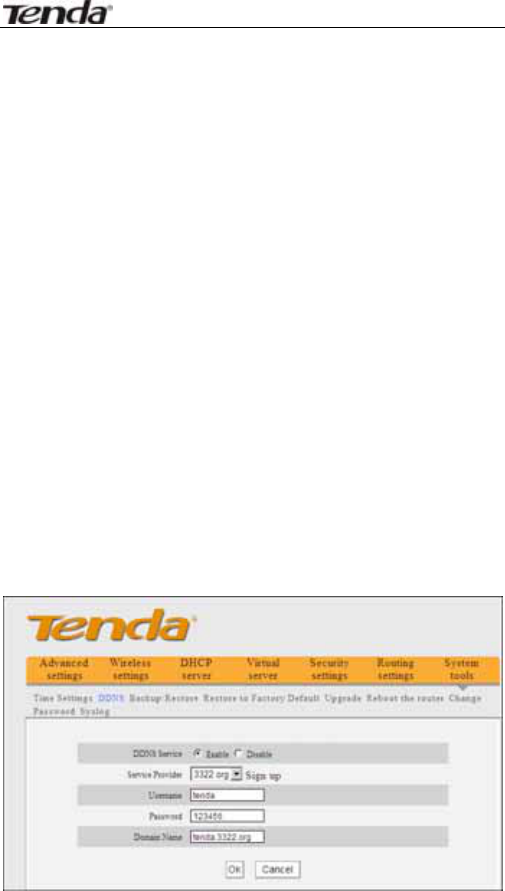
11N Wireless Broadband Router User Guide
71
Internet. Only when you connect to the Internet
and obtain the GMT time or set the time on this
screen, can the time settings in other functions
(e.g. security settings) take effect.
10.2 DDNS
The DDNS (Dynamic Domain Name System) is
supported in this Router. It is used to assign a fixed host
and domain name to a dynamic Internet IP address.
Every time you access the Internet, the dynamic
domain name software installed on your host will tell the
ISP’S host server its dynamic IP address by sending
messages. And the server software is responsible for
providing DNS service and implementing dynamic
domain name resolution.

11N Wireless Broadband Router User Guide
72
¾ Main features:
1. Mostly, your ISP provides a dynamic IP address
and the DDNS is used to capture the changeable IP
address and match to the fixed domain. Then users
can have access to the Internet to communicate
with others outside the network.
2. DDNS can help you to establish a virtual host in
your home or company.
¾ DDNS: Click the radio button to enable or disable
the DDNS service.
¾ Service provider: Select one from the drop-down
list and click “Sign up” for registration.
¾ Username: Enter the username that you use to
register from the DDNS provider
¾ Password: Enter the password that you use to
register from the DDNS provider
¾ Domain name: Enter the effective registered
domain name
For example:
Establish a Web server in the local host 192.168.0.10
and register in 3322.org as follows:
Username Tenda
Password 123456
Domain Name tenda.3322.org
After mapping the port in the virtual server, and setting
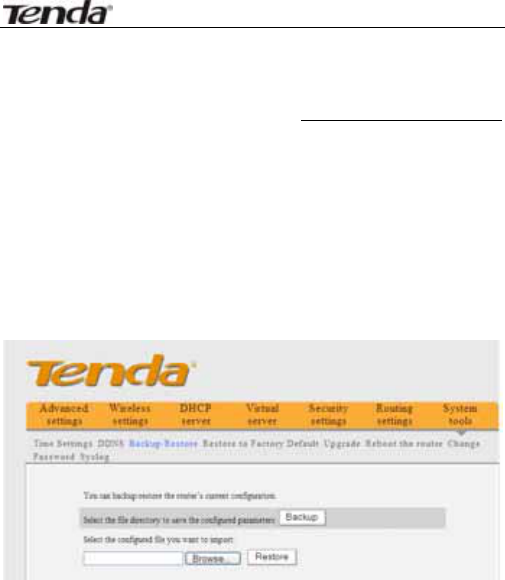
11N Wireless Broadband Router User Guide
73
account information in DDNS server, you can then
access the web page by entering http://tenda.3322.org
in the address field.
10.3 Backup/Restore
On this screen, you can back up the router’s current
settings or restore previous settings.
¾ Backup Setting:
Click the Backup button to back up the Router’s
settings and select a path to save them.
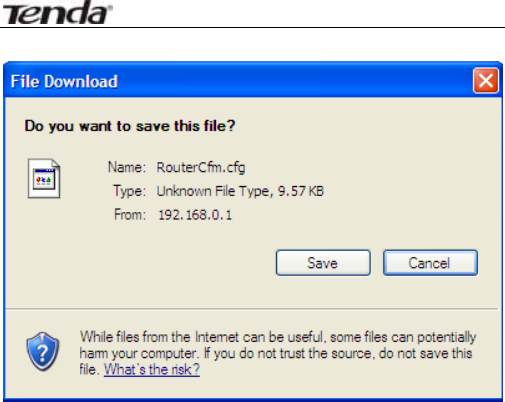
11N Wireless Broadband Router User Guide
74
Click the “Save” button to save the configuration
files.
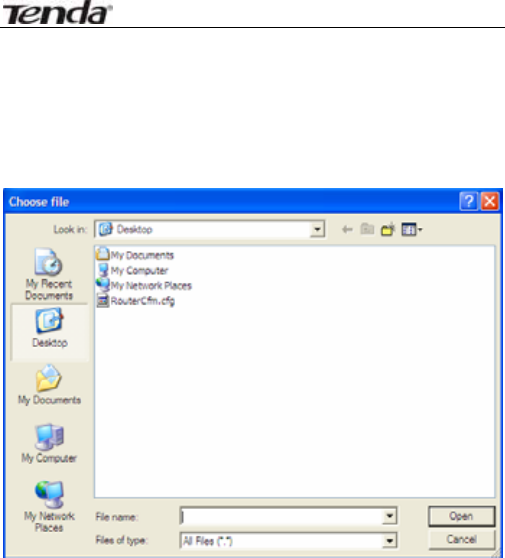
11N Wireless Broadband Router User Guide
75
¾ Restore Setting:
Click the “Browse” button to select the backup
files.
Click the “Restore” button to restore previous
settings.

11N Wireless Broadband Router User Guide
76

11N Wireless Broadband Router User Guide
77
10.4 Restore to Factory Default
This screen allows you to restore all settings to the
factory default values.
¾ Restore: Click this button to restore to default
settings.
¾ Factory default settings:
Password: admin
IP address: 192.168.0.1
Subnet mask: 255.255.255.0
NOTE:
After restoring to default settings, please restart
the router to make the default settings effective.
10.5 Upgrade
By upgrading the router’s software, you’ll get better
software version and appreciated routing function.
Before upgrading, download the Router’s software
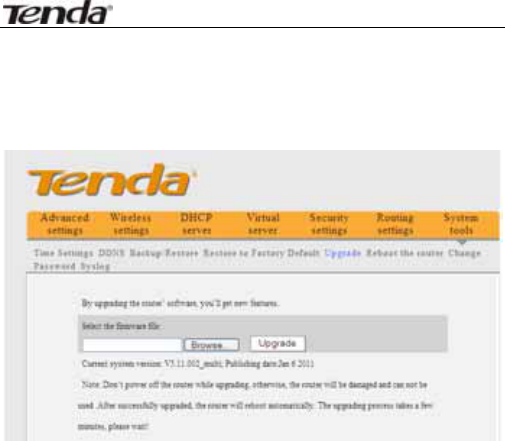
11N Wireless Broadband Router User Guide
78
upgrade file from our website, www.tenda.cn.
¾ Browse: Click this button to select the upgrade
file.
¾ Upgrade: Click this button to start the upgrading
process. After the upgrade is completed, the router
will reboot automatically.
10.6 Reboot the Router
Reboot the router to make the configuration effective.
The router will cut its WAN connection automatically
after rebooting.
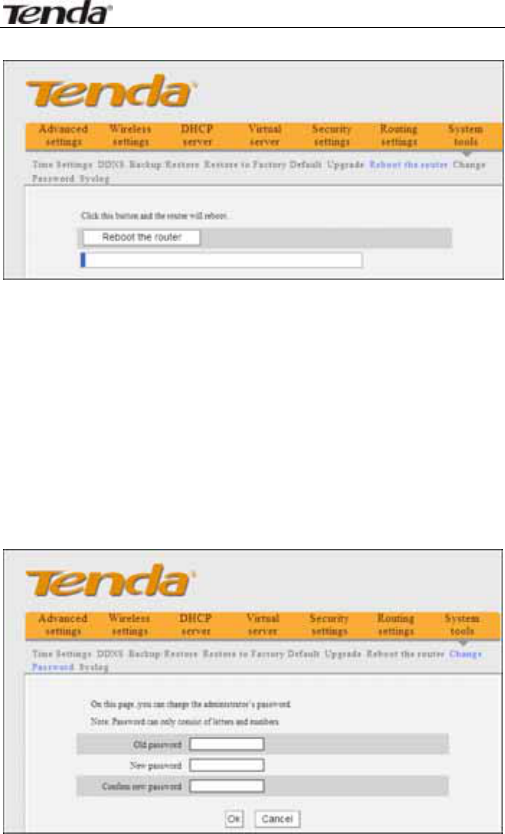
11N Wireless Broadband Router User Guide
79
Reboot the router: Click this button to reboot the
router.
10.7 Password Change
This section is to set a new password to better secure
your router and network.
¾ Old password: Enter the old password.
¾ New password: Enter a new password.

11N Wireless Broadband Router User Guide
80
¾ Confirm new password: Re-enter to confirm the
new password.
NOTE:
To secure the router and your network, it is highly
recommended that you change the initial
password.

11N Wireless Broadband Router User Guide
81
10.8 Syslog
The section is to view the system log. You can view
various conditions appearing after system start, and
also check whether there’s an attack on the network.
The log can record at most 150 entries.
¾ Refresh: Click this button to update the log.
¾ Clear: Click this button to clear the current shown
log.

11N Wireless Broadband Router User Guide
82
10.9 Log out
After all settings are finished, please click’” Log out” to
exit securely and completely.

11N Wireless Broadband Router User Guide
83
Appendix 1 Glossary
Channel:
An instance of medium use for the purpose of passing
protocol data units (PDUs) that may be used
simultaneously, in the same volume of space, with other
instances of medium use(on other channels) by other
instances of the same physical layer (PHY),with an
acceptably low frame error ratio(FER) due to mutual
interference.
SSID:
SSID (Service Set Identifier) is the network name
shared by all devices in a wireless network. Your
network’s SSID should be unique to your network and
identical for all devices within the network. It is
case-sensitive and must not exceed 20 characters (use
any of the characters on the keyboard).Make sure this
setting is the same for all devices in your wireless
network.
WPA/WPA2 Encryption:
A security protocol for wireless networks that builds on
the basic foundations of WEP. It secures wireless data
transmission by using a key similar to WEP, but the
added strength of WPA is that the key changes
dynamically. The changing key makes it much more
difficult for a hacker to learn the key and gain access to

11N Wireless Broadband Router User Guide
84
the network.WPA2 is the second generation of WPA
security and provides a stronger encryption mechanism
through Advanced Encryption Standard (AES), which is
a requirement for some government users.
802,1x authentication
Static WEP key is difficult to manage for when you
change the key, you will have to inform all others, and if
the key is disclosed in one of the places, the key can no
longer provide security. Besides, there’s severe security
loophole about static WEP encryption. The WEP key can
be decrypted after one person receives a specific
amount of data via wireless intercepting. 802,1x is
initially used for wired Ethernet authentication access to
prevent illegal users from accessing the network. Later,
it is found that 802.1x can better solve the wireless
network security problem. EAP-TLS of the 802.1x
successfully achieves the two-way authentication
between users and networks, i.e. can prevent illegal
users from accessing the network and can also prevent
users from accessing the illegal AP. 802.1x utilizes
dynamic WEP encryption to protect the WEP key from
being decrypted. To solve the publishing problem for
digital certification, people make some changes to TLS
authentication and TTLS and EAP come into exist, which
enable you to access the network by using the
traditional way of authentication: username and
password.

11N Wireless Broadband Router User Guide
85
Appendix 2 Product Features
z Supports IEEE 802.11n, IEEE 802.11g, IEEE
802.11b, IEEE 802.3 and IEEE 802.3u standards.
z 5dBi high gain omni-directional antenna, with
strong signals and long transmission distance.
z Wireless transmission rate up to 150Mbps
z Provides one 10/100Mbps auto-negotiation
Ethernet WAN port to connect to the Wide Area
Network
z Provides four 10/100Mbps auto-negotiation
Ethernet LAN ports to connect to the Local Area
Network
z Supports Auto MDI/MDIX
z Supports xDSL/Cable MODEM, static and dynamic
IP in community broadband networking
z Includes router, wireless access point, four-port
switch and firewall all in one
z SupportsWPA-PSK,WPA2-PSK,andWPA-PSK&WPA2
-PSK mixed security modes
z Supports WPS button
z Supports hidden SSID function and MAC
address-based access control
z Supports WMM to make your audio and video
smoother
z Supports SNTP
z Supports UPnP and DDNS

11N Wireless Broadband Router User Guide
86
z Supports WDS to extend wireless network
z Supports virtual server, DMZ host
z Provides syslog to record the running status of the
router
Appendix 3 FAQ
This section provides some solutions to the problems
which may occur during the router’s installation or
usage. The instructions below may help you deal with
the problems. If your problem is not in the list, please
log into our website www.tenda.cn or send an E-mail to
support@tenda.cn, and we will reply to you at the
earliest time.
1. Can not log in to the Web-based Utility of the router
after you enter the IP address in the address field?
Step 1: Check if the router is working correctly, after
the device is powered on for a few seconds, the SYS
indicator on the front panel should light up. If it is not,
please contact us.
Step 2: Check the network cables are connected
correctly and the corresponding LED indicator lights up.
Sometimes, the indicator lights up, but it does not mean
it is functioning.
Step 3: Run “Ping” command and check if it can ping

11N Wireless Broadband Router User Guide
87
the Router’s LAN IP address 192.168.0.1 (open
“Command Prompt” and type “Ping 192.168.0.1” and
then enter). If it is OK, please make sure your browser
does not access the Internet by proxy server. If the ping
fails, you can press the “RESET” button for 7 seconds to
restore to default settings. And then repeat the ping
operation. If it still does not work, please contact us.
2. Forgot the login password and cannot enter the
Web-based Utility. What can I do?
Press the “RESET” button for 7 seconds to restore the
Router to default settings.
3. The computer connected with the Router shows
IP address conflict. What can I do?
Check if there are other DHCP servers in the LAN and if
there are then disable them. The default IP address of
the router is 192.168.0.1 please maker sure the
address is not being used by any other device. If there
are two computers with the same IP address, please
change one of them.
4. I cannot use E-mail and access the Internet.
What can I do?
Sometimes happens with ADSL connection and
Dynamic IP users. You may need to modify the default
MTU value (1492). Please open the “WAN Setting” and
modify the MTU value with the recommended value as

11N Wireless Broadband Router User Guide
88
1450 or 1400.
5.How to share my computer’s resource with
other users in Internet?
If you want Internet users to access the internal server
via the router such as: e-mail server, Web, FTP. You can
configure the “Virtual Server”.
Step 1: create your internal server, make sure the LAN
users can access these servers and know related service
port. For example, Web server’s port is 80; FTP is 21;
SMTP is 25 and POP3 is 110.
Step 2: In the router’s web click “Virtual Server” and
select “Port Range Forwarding”.
Step 3: Input the service port provided by the router
(i.e. the external port) for mapping the internal and
external network, for example, 80-80.
Step 4: input the internal Web service port, for example,
80-80.
Step 5: Input the internal server’s IP address. For
example, if your Web server’s IP address is
192.168.0.10, please input it.
Step 6: select the communication protocol used by your
internal host: TCP, UDP, Both.
Step 7: click “Ok” to activate the settings.
The following table lists some well-known applications
and their respective service ports:
Server Protocol
Service Port
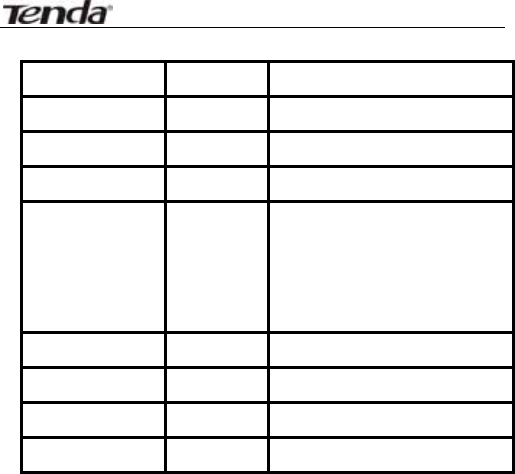
11N Wireless Broadband Router User Guide
89
WEB Server TCP 80
FTP Server TCP 21
Telnet TCP 23
NetMeeting TCP 1503、1720
MSN
Messenger TCP/UDP
File
Send:6891-6900(TCP)
Voice:1863、6901(TCP)
Voice:1863、5190(UDP)
PPTP VPN TCP 1723
Iphone5.0 TCP 22555
SMTP TCP 25
POP3 TCP 110
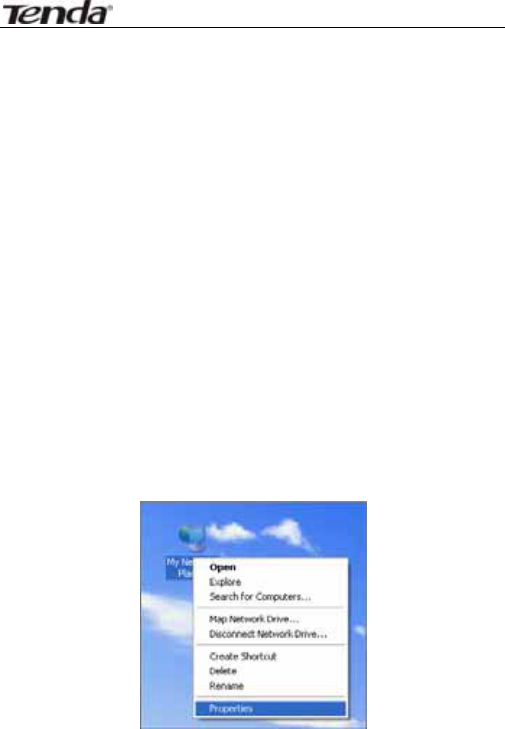
11N Wireless Broadband Router User Guide
90
Appendix 4 Clear Wireless
Configuration
Clear Wireless configuration file under windows
XP
1. Right click “My Network Places” on your computer
desktop and select “Properties”.
2. Right click “Wireless Network Connections” and
select “Properties”.
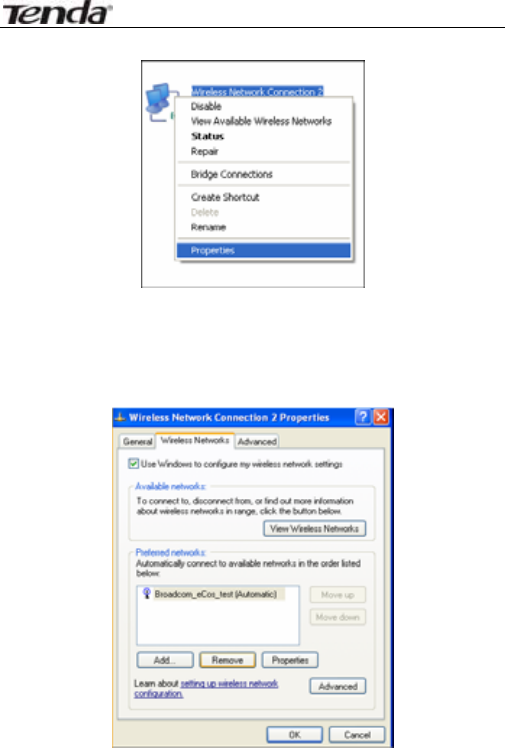
11N Wireless Broadband Router User Guide
91
3. Click “Wireless Network Configuration” and clear the
corresponding wireless configuration file as shown
below.
Clear Wireless configuration file under windows 7
1. Right click “Network” and click “Properties”.
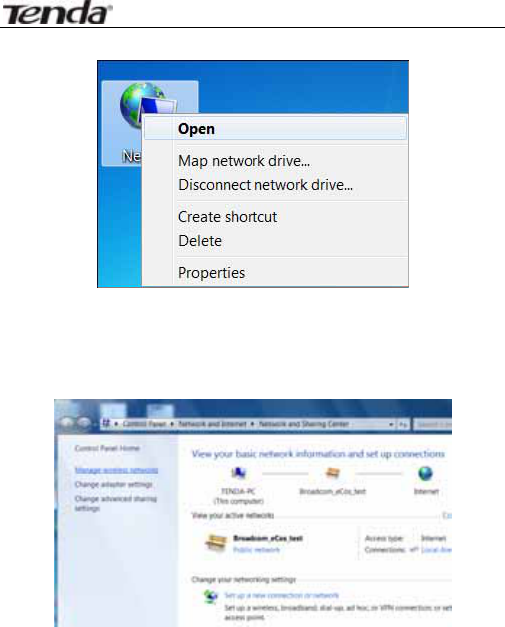
11N Wireless Broadband Router User Guide
92
2. Click “Manage wireless networks” on the left side of
the window.
3. Delete the corresponding configured file in the
“Manage wireless networks”.
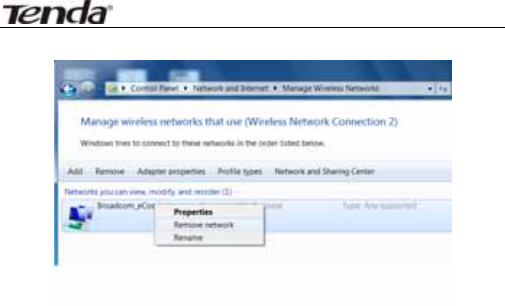
11N Wireless Broadband Router User Guide
93

11N Wireless Broadband Router User Guide
94
Appendix 5 Regulatory Information
EU Declaration or Declaration of Conformity
Hereby, SHENZHEN TENDA TECHNOLOGY CO.,LTD,
declares that this Wireless Broadband Router is in
compliance with the essential requirements and other
relevant provisions of Directive 1999/5/EC.
FCC Statement
This equipment has been tested and found to comply
with the limits for a Class B digital device, pursuant to
part 15 of the FCC rules. These limits are designed to
provide reasonable protection against harmful
interference in a residential installation. This equipment
generates, uses and can radiate radio frequency energy
and, if not installed and used in accordance with the
instructions, may cause harmful interference to radio
communications. However, there is no guarantee that
interference will not occur in a particular installation. If
this equipment does cause harmful interference
to radio or television reception, which can be
determined by turning the equipment off and on, the
user is encouraged to try to correct the interference by
one or more of the following measures:
-Reorient or relocate the receiving antenna.
-Increase the separation between the equipment and
receiver.

11N Wireless Broadband Router User Guide
95
-Connect the equipment into an outlet on a circuit
different from that to which the receiver is connected.
-Consult the dealer or an experienced radio/TV
technician for help.
To assure continued compliance, any changes or
modifications not expressly approved by the party
responsible for compliance could void the user’s
authority to operate this equipment. (Example- use only
shielded interface cables when connecting to computer
or peripheral devices).
“The antenna(s) used for this transmitter must not be
co-located or operating in conjunction with any other
antenna or transmitter.”
FCC Radiation Exposure Statement
This device complies with Part 15 of the FCC Rules.
Operation is subject to the following two conditions: (1)
this device may not cause harmful interference, and (2)
this device must accept any interference received,
including interference that may cause undesired
operation